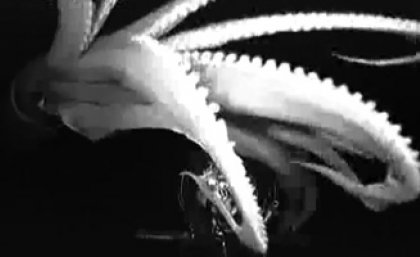
Researchers from The University of Queensland played a key role in filming the first video images of a live giant squid in its natural habitat, in lightless water up to a kilometre under the ocean.
PhD student Wen-Sung Chung, from the Queensland Brain Institute at UQ, assisting Dr Edith Widder, operated Medusa, a remote-controlled underwater camera craft that filmed the squid last northern summer near the Ogasawara Islands, 1000km south of Japan. Mr Chung participated in a deep-sea expedition organised by NHK (Japan Broadcasting Corporation), NHK Enterprises, and Discovery Channel.
The Discovery Channel — along with Japanese public television network NHK — broadcast the video to a mass worldwide audience last month. The video was filmed with the UQ-designed camera system.
The QBI’s Professor Justin Marshall said still photographs were taken of live giant squid (Architeuthis dux) for the first time only in 2004.
Professor Marshall — a visual neuroscientist and an expert in animal colouration - said people had known about giant squid for millenia.
“There are many recorded instances of them washing up on beaches,” he said. “Approximately 30 giant squid are preserved and displayed in museums around the world.
“But video of these remarkable creatures, alive and in their natural habitat, tells us so much more about them, their characteristics and habits than we knew previously,” Professor Marshall said.
“This is cutting edge deep-sea research at its best.
“Their habitat is very deep in the ocean — between 600m and 1km down — so capturing the video required a major international team effort and years of planning.
“Numerous attempts in the past have failed.”
Professor Marshall said the Australian Research Council funded the project to build the first Medusa camera platform.
“It followed on the design of Dr Widder's Eye-In-the-Sea (EITS) but dramatically augmented that system's launch capabilities, allowing scientists to film deep-sea life in situ,” he said.
Mr Chung said during the expedition, the team made more than 100 dives totaling 400 hours.
Two submersibles, the Medusa camera platform and a new ship, MV Alucia (which Professor Marshall helped design), two film crews and four scientific teams —including 50 scientists and engineers from 11 countries — were involved in last year’s expedition.
“We developed a special ultra-sensitive high-definition camera for the Meduca platforms to operate under the high-pressure conditions in the ocean depths,” Professor Marshall said.
“The light it uses to illuminate the video shots is red, wavelengths derived by Dr Widder's research with funding from the Monterey Bay Aquarium Research Institute. These wavelengths are invisible to the giant squid’s blue-sensitive eye.”
Mr Chung said giant squid could grow to 18 metres, with two long tentacles comprising up to two thirds of that length.
The squid filmed by Medusa on the NHK/NEP/Discovery expedition was 3 metres, but it was missing its characteristic two longest tentacles.
“If the tentacles had been intact, the creature probably would have measured seven to eight metres,” Mr Chung said.
Professor Marshall said the giant squid had an extraordinary, metallic-coloured skin.
“Almost everything we know about deep-sea animals is from catching them and bringing them on board a boat,” he said.
“From the work done on this expedition, we now have evidence that the giant squid responds to smell — as it is drawn to the bait — and to luminescence. We used blue bioluminescence lures to attract the squid.
“The video shows that as the squid discovers the Medusa, its tentacles explore the craft and then the creature moves off very quickly when it realises it is not edible.
“The shots looking into the squid’s eye are amazing. Giant squids have the biggest eyeball on the planet – they are as big as an adult human head.”
Professor Marshall said sperm whales were one of the well-known predators of giant squid.
NHK, NHK Enterprises and Discovery Channel jointly funded the expedition.
Dr Tsunemi Kubodera, collection director and head of the Center for Molecular Biodiversity Research at Japan’s National Museum of Nature and Science, was the expedition’s leading scientist, after spending the previous decade studying giant squids.
Other leading scientists on the project included Dr Edie Widder from the Ocean Research and Conservation Association (ORCA) and marine biologist and squid expert Dr Steve O’Shea from the Auckland University of Technology.
Dr Widder drew on National Science Foundation funding to purchase the Medusa usedon the expedition. Other contributions came from the MV Alucia ship and sub crew, and from Harbour Branch Oceanographic Institute and Blue Turtle Engineering in Florida, and ORCA, the organisations with which Professor Marshall designed the Medusa camera platforms.
Two of these platforms are now at UQ in Brisbane, being prepared for a project in the Coral Sea in mid 2013.
A paper published in the academic journal Biological Conservation in 2011 reported that 677 giant squid specimens were known to have been found or caught since the 16th century.
The creatures have been the subject of legendary stories since ancient times, with tales sometimes reckoning they can grow to more than 75 metres. But as Scientific American reported in 1982, there is no firm evidence for such assertions.
“The usual basis for them is the size of sucker scars on whales, but since a scar grows as a whale grows, it is unreliable evidence for the size of a squid unless it is demonstrably recent,” the magazine reported.
The largest specimen recorded in scientific literature measured 20 metres in total length; it was stranded on a New Zealand beach in 1880.
Available for interview: Wen-Sung Chung, QBI, ph +61 (0) 409 551 126 (Australia), +88 6 935721392 (Taiwan), wensung.chung@gmail.com
Professor Justin Marshall, ph +61 7 3365 1400, +61 (0) 423 024 162, justin.marshall@uq.edu.au
Media contact, and to source additional footage: Fiona Cameron, UQ Communications, ph +61 7 3365 1120, communications@uq.edu.au
Links: CNN news report, 5:30 mins, screened 27 Jan 2013
Dr Edie Widder interviewed on CBS morning news, 3:51 mins, 24 Jan 2013
Marshall lab website
.jpg)









